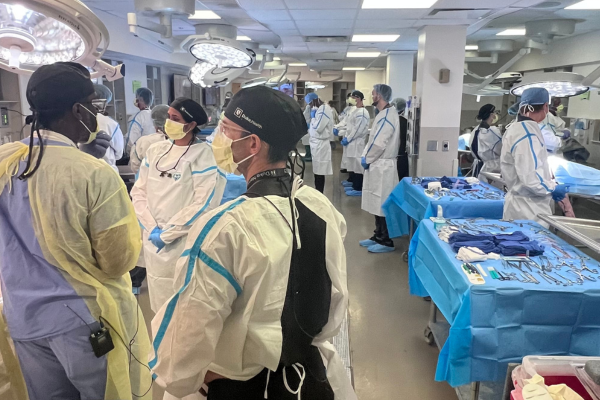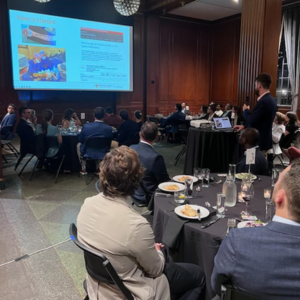
The Duke Nerve Center held its second annual Duke Nerve Course, a practical cadaver-based training program designed to enhance skills in peripheral nerve and microvascular surgery. Taking place September 5–6, the event gathered a select group of 25 residents and fellows for an immersive experience focused on collaboration across orthopaedics, plastic surgery, and neurosurgery.
Led by course organizers Dr. Neill Li, an assistant professor of Orthopaedic Surgery and Neurosurgery; Dr. Eliana Saltzman, an assistant professor of Orthopaedic Surgery; and Dr. Linda Cendales, a Professor of Surgery, the 2025 program was built around a unique multidisciplinary approach that combined perspectives from surgical specialties and industry partners.
“There’s still so much unknown in nerve surgery,” said Dr. Li. “We designed this course to break down silos and promote real-time learning through shared challenges and hands-on practice across disciplines and institutions.”
A Collaborative Approach to Complex Surgery
What distinguished the Duke Nerve Course was its small, interactive format and diverse faculty from Duke University, the University of North Carolina at Chapel Hill, Wake Forest University, and East Carolina University. The limited participant number guaranteed personalized instruction and full access to cadaveric stations, enabling learners to engage closely with complex dissections and microsurgical techniques.
Each session began with a demonstration, followed by extensive hands-on practice, during which faculty members circulated to offer guidance, share techniques, and promote discussion. “Sometimes perspectives were at odds—and that’s a good thing,” said Dr. Saltzman. “It sparked critical thinking and helped participants understand the nuances of nerve repair and microvascular surgery.”

Immersive Microvascular Lab and Real-World Challenges
Under the guidance of Dr. Cendales, a leading microvascular surgeon and head of the hand transplantation program at Duke, participants started with a microvascular course to develop skills in blood vessel and nerve repair using microscopes, couplers, and advanced nerve repair tools. They were then divided into small groups—no more than three per cadaver—to ensure focused instruction and provide the opportunity to experience the challenges and successes involved in mastering delicate surgical techniques.
“Our goal was to replicate the real challenges of surgery,” said Dr. Li. “Watching isn’t the same as doing. We wanted learners to experience the struggle and learn through trial and error, with support from faculty across multiple disciplines.”
Building the Future of Nerve Surgery
This year’s theme, "Foundations & Frontiers in Brachial Plexus, Peripheral Nerve, and Microvascular Surgery," reflected the Duke Nerve Center’s broader mission: to unify surgical disciplines through collaboration and improve outcomes through education and innovation. This was combined with industry participation, where cutting-edge nerve devices and technologies were presented and evaluated with the faculty and participants to not only showcase growing resources in nerve but also be crucial in assessing how we advance the development and usefulness of such emerging technologies.
“We’re building an educational arm that not only spans institutions and specialties but also collaborates with industry partners to understand and adapt to new technologies,” said Dr. Li.
Multicenter collaboration along with diverse translational perspectives is essential for advancing the field, especially in nerve surgery, where outcomes remain inconsistent and improving the biology of nerve regeneration is crucial.
Looking ahead, the organizers plan to expand a rotating curriculum that covers lower extremity, amputation, and upper motor neuron injuries to establish the Duke Nerve Course as a national leader in personalized cadaveric training. We’re committed to inspiring the next generation of surgeons and giving our patients confidence that we’re constantly learning, collaborating, and striving to provide the best care possible.
We thank those who provided support and shared their expertise: Mark Attiah, MD, UNC; Linda Cendales, MD, Duke; Chris Dibble, MD, Wake Forest; Cassandra Driscoll, MD, Wake Forest; Warren Hammert, MD, Duke; Neill Li, MD, Duke; Suhail Mithani, Duke; Orlando Merced-O’Neill, UT San Antonio; Sneha Rao, MD, Wake Forest; Eliana Saltzman, MD, Duke; and Kevin Taylor, MD, ECU.